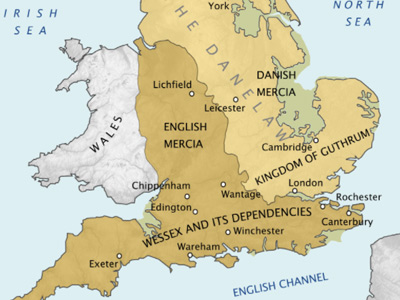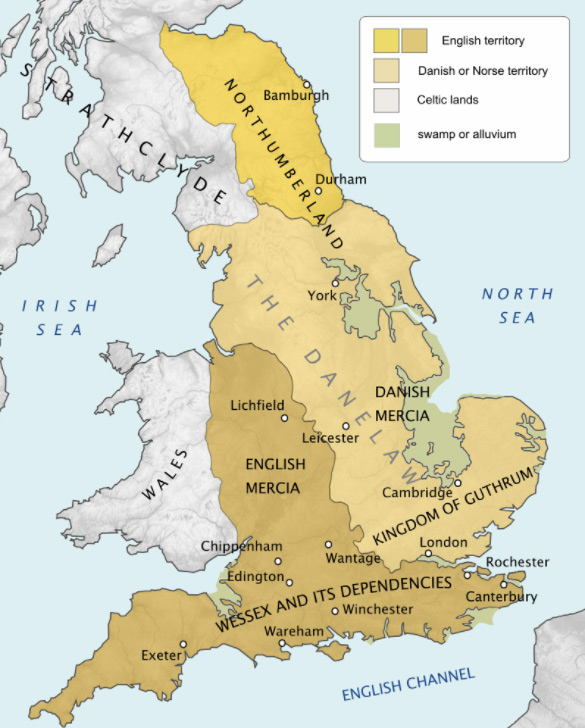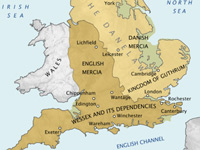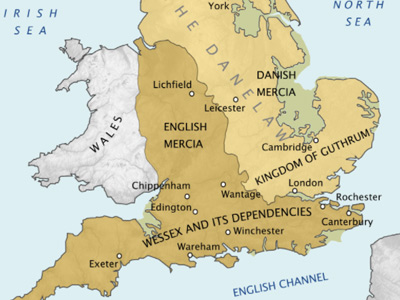Battle of Edington (878 AD)

Consequences
Three weeks after the battle, Guthrum was baptized at Aller with Alfred as his sponsor. It is possible that the enforced conversion was an attempt by Alfred to lock Guthrum into a Christian code of ethics, hoping it would ensure the Danes' compliance with any treaties agreed to. The converted Guthrum took the baptismal name of Athelstan.
Under the terms of the Treaty of Wedmore, the converted Guthrum was required to leave Wessex and return to East Anglia. Consequently, in 879 the Viking army left Chippenham and made its way to Cirencester and remained there for a year. The following year the army went to East Anglia, where it settled.

England, 878
Also in 879, according to Asser, another Viking army sailed up the River Thames and wintered at Fulham. Over the next few years this particular Danish faction had several encounters with Alfred's forces. However, Alfred managed to contain this threat by reforming his military and setting up a system of fortified cities, known as burghs or burhs.
In 885 Asser reports that the Viking army that had settled in East Anglia had broken in a most insolent manner the peace they had established with Alfred, although Guthrum is not mentioned. Guthrum reigned as king in East Anglia until his death in 890, and although this period was not always peaceful he was not considered a threat.
Advertisement

These books are available for download with iBooks on your Mac or iOS device, and with iTunes on your computer. Books can be read with iBooks on your Mac or iOS device.

These books are available for download with iBooks on your Mac or iOS device, and with iTunes on your computer. Books can be read with iBooks on your Mac or iOS device.
( Click image to enlarge)
In 886, the Treaty of Alfred and Guthrum defined the boundaries of their two kingdoms. The kingdom of Mercia was divided up, with part going to Alfred's Wessex and the other part to Guthrum's East Anglia. The agreement also defined the social classes of Danish East Anglia and their equivalents in Wessex. It tried to provide a framework that would minimize conflict and regulate commerce between the two peoples. It is not clear how seriously Guthrum took his conversion to Christianity, but he was the first of the Danish rulers of the English kingdoms to mint coins on the Alfredian model, under his baptismal name of Athelstan. By the end of the 9th century all of the Anglo-Danish rulers were minting coins too. By the 10th century the Anglo-Saxon model of kingship seems to have been universally adopted by the Anglo-Danish leadership.
After the defeat of Guthrum at the Battle of Edington, Alfred's reforms to military obligations in Wessex made it increasingly difficult for the Vikings to raid successfully. By 896 the Vikings gave up with some going to East Anglia and others going to Northumbria. It was under Alfred that the Viking threat was contained. However, the system of military reforms and the Burghal Hidage introduced by Edward the Elder enabled Alfred's successors to retake control of the lands occupied in the North of England by the Danes.
HISTORY

RESOURCES
This article uses material from the Wikipedia article "Battle of Edington (878 AD)", which is released under the Creative Commons Attribution-Share-Alike License 3.0.
© Stories Preschool. All Rights Reserved.









